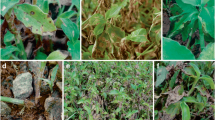Abstract
Lonicera japonica (Japanese honeysuckle), a plant of Asian origin introduced as an ornamental into many countries, has become an invasive weed in some exotic situations, such as in southern Brazil. Classical biological control (CBC) with natural enemies collected in the centre of origin is considered to be the best alternative for sustainable management of L. japonica. In the context of this strategy, previous knowledge of the natural enemies already present in the target area is of great importance in order to avoid un-necessary introductions of CBC agents from the weed’s native range. Recently, examination of populations of L. japonica in localities in the Brazilian states of Rio de Janeiro and Paraná revealed the presence of leaf spots consistently associated with a cercosporoid hyphomycete. A molecular and morphological study of this fungus led to its recognition as Pseudocercospora lonicerigena. There were few differences when the Brazilian isolate was compared with a strain found in North America. This is the first report of this fungus in Brazil. The fungus was isolated in pure culture and inoculation of healthy leaves of L. japonica eventually led to leaf yellowing and necrosis, indicating that P. lonicerigena is not highly pathogenic, as evidenced by the continuing advance of this weed in southern Brazil. Therefore, the introduction of additional co-evolved natural enemies collected in Asia, perhaps piggy-backing on an ongoing project already underway in New Zealand, will be necessary to control this invasive alien weed in Brazil.


Similar content being viewed by others
References
Alcorn JL (1988) The taxonomy of “Helminthosporium” species. Annu Rev Phytopathol 26:37–56
Barreto RW (2009) Controle biológico de plantas invasoras. Inf Agrop 30:93–106
Braun U, Crous PW (2007) The diversity of cercosporoid hyphomycetes – new species, combinations, names and nomenclatural clarifications. Fungal Divers 26:55–72
Carbone I, Kohn LM (1999) A method for designing primer sets for speciation studies in filamentous ascomycetes. Mycologia 91:553–556
Cronk QCB, Fuller JL (1995) Plant invaders. Chapman and Hall, London
Crous PW, Verkley GJM, Groenewald JZ, Samson RA (eds). (2009) Fungal biodiversity. CBS Laboratory Manual Series. Centraalbureau voor Schimmelcultures, Utrecht, Netherlands, pp 1: 1–269
Crous PW, Braun U, Hunter GC, Wingfield MJ, Verkley GJM, Shin HD, Nakashima C, Groenewald JZ (2012) Phylogenetic lineages in Pseudocercospora. Stud Mycol 75:37–114
Deighton FC (1976) Studies on Cercospora and allied genera. VI. Pseudocercospora Speg., Pantospora Cif. and Cercoseptoria Petr. Mycol Pap 140:1–168
Guo YL, Hsieh WH (1995) The genus Pseudocercospora in China. Mycosyst Monogr Ser 2:1–88
Huelsenbeck JP, Ronquist F (2001) MrBayes: Bayesian inference of phylogeny. Bioinformatics 17:754–755
Kumar N, Singh B, Bhandari P, Gupta AP, Uniyal SK, Kaul VK (2005) Biflavonoids from Lonicera japonica. Phytochemistry 66:2740–2744
Lorenzi H, Souza HM (1995) Plantas ornamentais no Brasil: arbustivas, herbáceas e trepadeiras. Instituto Plantarum, Nova Odessa
Nylander JAA (2004) MrModeltest v2. Program distributed by the author. Uppsala University: Evolutionary Biology Centre
Pereira JM, Barreto RW, Ellison C, Maffia LA (2003) Corynespora cassiicola f. sp. lantanae: a potential biocontrol agent for Lantana camara from Brazil. Biol Control 26:21–31
Rambaut A (2009) Figtree V1.3.1. Retrieved 5 May 2013 from http://tree.bio.ed.ac.uk/
Rambaut A, Drummond AJ (2003) Tracer v1.5. Retrieved 5 May 2013 from http://evolve.zoo.ox.ac.uk/
Rayner RW (1970) A mycological colour chart. Commonwealth Mycological Institute, Kew
Schneider AA (2007) A flora naturalizada no estado do Rio Grande do Sul, Brasil: herbáceas subespontâneas. Biociencias 5:257–268
Shang X, Pan H, Li M, Miao X, Ding H (2011) Lonicera japonica Thunb.: ethnopharmacology, phytochemistry and pharmacology of an important traditional Chinese medicine. J Ethnopharmacol 138:1–21
Soares DJ, Barreto RW (2008) Fungal pathogens of the invasive riparian weed Hedychium coronarium from Brazil and their potential for biological control. Fungal Divers 28:85–96
Staden R (1996) The staden sequence analysis package. Mol Biotechnol 5:233–241
Viégas AP (1946) Alguns fungos do Brasil XIII – Hifomicetos. Bragantia 6:380
Waipara NW, Winks CJ, Smith LA, Wilkie JP (2007) Natural enemies of japanese honeysuckle, Lonicera japonica, in New Zealand. N Z Plant Prot 60:158–163
White TJ, Bruns T, Lee S, Taylor JW (1990) Amplification and direct sequencing of fungal ribosomal RNA genes for phylogenetics. In: Innis MA, Gelfand DH, Sninsky JJ, White TJ (eds) PCR protocols: a guide to methods and applications. Academic Press, Inc., New York, pp 315–322
Author information
Authors and Affiliations
Corresponding author
Rights and permissions
About this article
Cite this article
de Miranda, B.E.C., Ferreira, B.W., Alves, J.L. et al. Pseudocercospora lonicerigena a leaf spot fungus on the invasive weed Lonicera japonica in Brazil. Australasian Plant Pathol. 43, 339–345 (2014). https://doi.org/10.1007/s13313-014-0275-x
Received:
Accepted:
Published:
Issue Date:
DOI: https://doi.org/10.1007/s13313-014-0275-x




